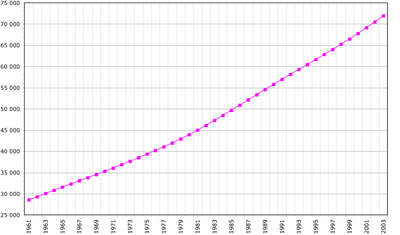Demographics of Egypt
This article is about the demographic features of the population of Egypt, including population density, ethnicity, education level, health of the populace, economic status, religious affiliations and other aspects of the population.
| Life in Egypt | |
|---|---|

|
|
| Culture | |
| Cuisine | |
| Cinema | |
| Music | |
| Media | |
| Tourism | |
| Holidays | |
| Healthcare | |
| Demography | |
| People | |
| Languages | |
| Religion | |
| Human rights | |
| Politics | |
| Parliament | |
| Military | |
| Economy | |
| Transportation | |
| Communications | |
| Education | |
| Wildlife |
Egypt is the most populous country in the Middle East and the second-most populous on the African continent (after Nigeria). Nearly 100% of the country's 78,887,007 (2006 est.) people live in three major regions of the country: Cairo and Alexandria and elsewhere along the banks of the Nile; throughout the Nile delta, which fans out north of Cairo; and along the Suez Canal. These regions are among the world's most densely populated, containing an average of over 3,820 persons per square mile (1,540 per km².), as compared to 181 persons per sq. mi. for the country as a whole.
Small communities spread throughout the desert regions of Egypt are clustered around oases and historic trade and transportation routes. The government has tried with mixed success to encourage migration to newly irrigated land reclaimed from the desert. However, the proportion of the population living in rural areas has continued to decrease as people move to the cities in search of employment and a higher standard of living.
Overview
Egypt has endured as a unified state for more than 5,000 years, and archaeological findings show that primitive tribes lived along the Nile long before the dynastic history of the pharaohs began. In about 3150 BC, Egypt was united under a single ruler known as Mena, or Menes, who inaugurated the 30 pharaonic dynasties into which Egypt's ancient history is divided—the Old and Middle Kingdoms and the New Empire. The pyramids at Giza (near Cairo), which were built in the fourth dynasty, testify to the power of the pharaonic religion and state. The Great Pyramid, the tomb of Pharaoh Khufu (also known as Cheops), is the only remaining monument of the Seven Wonders of the Ancient World. Ancient Egypt reached the peak of its power, wealth, and territorial extent in the period called the New Empire (1567-1085 BC).
The last native dynasty fell to the Persians in 341 BC, who in turn were successively replaced by Greeks, Romans, Byzantines, Arabs, Turks and British. Almost fully independent from Britain in 1922, Egypt acquired full sovereignty following World War II. The completion of the Aswan High Dam in 1971 and the resultant Lake Nasser have altered the time-honored place of the Nile River in the agriculture and ecology of Egypt. A rapidly growing population, limited arable land, and dependence on the Nile all continue to overtax resources and stress society. The government has struggled to ready the economy for the new millennium through economic reform and massive investment in communications and physical infrastructure.
Genetics
Y-chromosome DNA
Y-Chromosome DNA Y-DNA represents the male lineage, The Egyptian Y-chromosome pool may be summarized as follows where haplogroups E1b1b1, J, R1 & G comprise generally more than 90% of the total chromosomes.[1]
- E1b1b1 ~ 45%
- J ~ 25%
- R1 ~ 10%
- G ~ 10%
- Other Haplogroups 10%
Population of Egypt

Egypt has a population of 77,680,000 (DEC 2009). According to the International Organization for Migration, an estimated 2.7 million Egyptians live abroad and contribte actively to the development of their country through remittances (US$ 7.8 in 2009), circulation of human and social capital, as well as investment. Approximately 70% of Egyptian migrants live in Arab countries (923,600 in Saudi Arabia, 332,600 in Libya, 226,850 in Jordan, 190,550 in Kuwait with the rest elsewhere in the region) and the remaining 30 % are living mostly in Europe and North America (318,000 in the US, 110,000 in Canada and 90,000 in Italy).[2]
The vast majority of the population of Egypt consists of ethnic Egyptians (94% of the population or 74.1 million according to the CIA Factbook, 72.5 million according to Al-Ahram Weekly). The vast majority of Egyptians are native speakers of modern Egyptian Arabic (Masri). According to the CIA World factbook, approximately 91% of the population is Muslim and 9% is Christian (8% Coptic Orthodox, 1% other Christian).
Ethnic minorities in Egypt include the Bedouin Arab tribes of the Sinai Peninsula and the eastern desert, the Berber-speaking community of the Siwa Oasis and the Nubian people clustered along the Nile in the southernmost part of Egypt. There are also sizable minorities of Beja and Dom.
The country was host to many different communities during the colonial period, including Greeks, Italians, Syrians, Jews and Armenians, though most either left or were compelled to leave after political developments in the 1950s. The country still hosts some 90,000 refugees and asylum seekers, mostly Palestinians and Sudanese.
Education
For more details see Education in Egypt.
The literacy rate in modern Egyptian society is highly debated. Education is free through university and compulsory from ages six through 15, though enforcement may be lax. Rates for primary and secondary education have strengthened in recent years. The vast majority of children enter primary school though a significant number drop out. There are approx. 200,000 primary and secondary schools with some 10 million students, 13 major universities with more than 500,000 students, and 67 teacher colleges. Major universities include AUC (American University in Cairo), Cairo University (100,000 students), Ain Shams University, Alexandria University, and the 1,000-year-old Al-Azhar University, one of the world's major centers of Islamic learning. The first lady has created many project towards the advancement of Egyptian education and the efforts to force education to the remaining 7-9% of students who drop out illegally. Child labor is a contributing factor to these dropouts but it is considered a serious crime to work children under the legal age and charges are taken very seriously at this time.
CIA World Factbook Demographic Statistics
The following demographic statistics are from the CIA World Factbook, unless otherwise indicated.
Population
* 83,082,869 (July 2008 est.)
Age structure
- 0-14 years: 31.8% no(male 13,292,961/female 12,690,711)
- 15-64 years: 63.5% (male 26,257,440/female 25,627,390)
- 65 years and over: 4.7% (male 1,636,560/female 2,208,455) (2008 est.)
Median Age
- Total: 24 (2007)
- Male: 24 (2007)
- Female: 24 (2007)
Population growth rate
- 1.75% (2006 est.)
Birth rate
- 22.12 births/1,000 population (2008 est.)
Death rate
- 5.23 deaths/1,000 population (2006 est.)
Net migration rate
- -0.21 migrant(s)/1,000 population (2006 est.)
Gender ratio
- at birth: 1.05 male(s)/female
- under 15 years: 1.05 male(s)/female
- 15-64 years: 1.02 male(s)/female
- 65 years and over: 0.74 male(s)/female
- total population: 1.02 male(s)/female (2006 est.)
Infant mortality rate
- 31.33 deaths/2,000 live births (2006 est.)
Life expectancy at birth
- total population: 71.29 years
- male: 68.77 years
- female: 73.93 years (2006 est.)
Total fertility rate
- 2.83 children born/woman (2006 est.)
Nationality
- noun: Egyptian(s)
- adjective: Egyptian
Ethnic groups
Egyptians 99.6%, other 0.4% (2006 census). Ethnic minorities include Bedouins (Beja, ca. 1 million), Nubians (ca. 300,000 in 1996), Dom (ca. 230,000 in 1996), Greeks (ca. 40,000), Berbers (ca. 5,000).
Religions
- Muslim 91%[6] (Sunni > 99%, Shia < 1%)
- Christianity ~9%[7] (Coptic Christian Other estimates range between 5% and 10% Christians).
- Bahá'í: less than 2,000 individuals (< 0.003%).
- Judaism: less than 200 individuals.
Languages
Arabic (official; see also Egyptian Arabic) English and French widely understood as well.
Literacy
- definition: age 15 and over can read and write
- total population: 71.4%
- male: 83%
- female: 59.4% (2005 est.)[1],,,,
References
 This article incorporates public domain material from the CIA World Factbook document "2006 edition".
This article incorporates public domain material from the CIA World Factbook document "2006 edition". This article incorporates public domain material from websites or documents of the United States Department of State (Background Notes).
This article incorporates public domain material from websites or documents of the United States Department of State (Background Notes).
- ↑ Arredi et al. 2004, Di Giacomo et al. 2004, Luis et al. 2004
- ↑ International Organization for Migration, http://www.egypt.iom.int/Doc/IOM%20Migration%20and%20Development%20in%20Egypt%20Facts%20and%20Figures%20(English).pdf
- ↑ International Religious Freedom Report 2006 - Egypt
- ↑ International Religious Freedom Report 2007 - Egypt
- ↑ CIA World Factbook - Egypt
- ↑ http://pewforum.org/newassets/images/reports/Muslimpopulation/Muslimpopulation.pdf
- ↑ http://pewforum.org/newassets/images/reports/Muslimpopulation/Muslimpopulation.pdf
See also
|
||||||||||||||||||||
|
|||||
|
|||||||||||
|
||||||||||||||